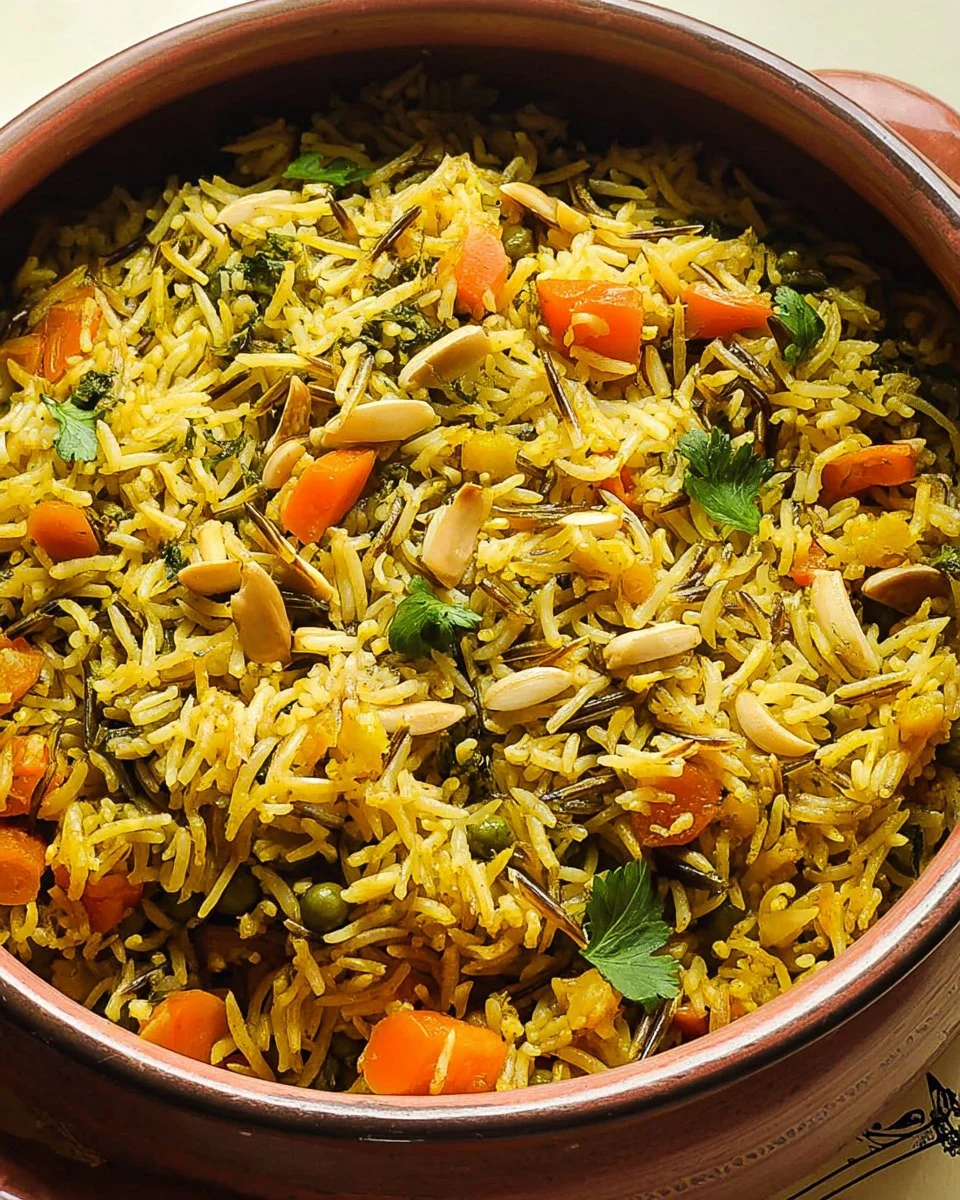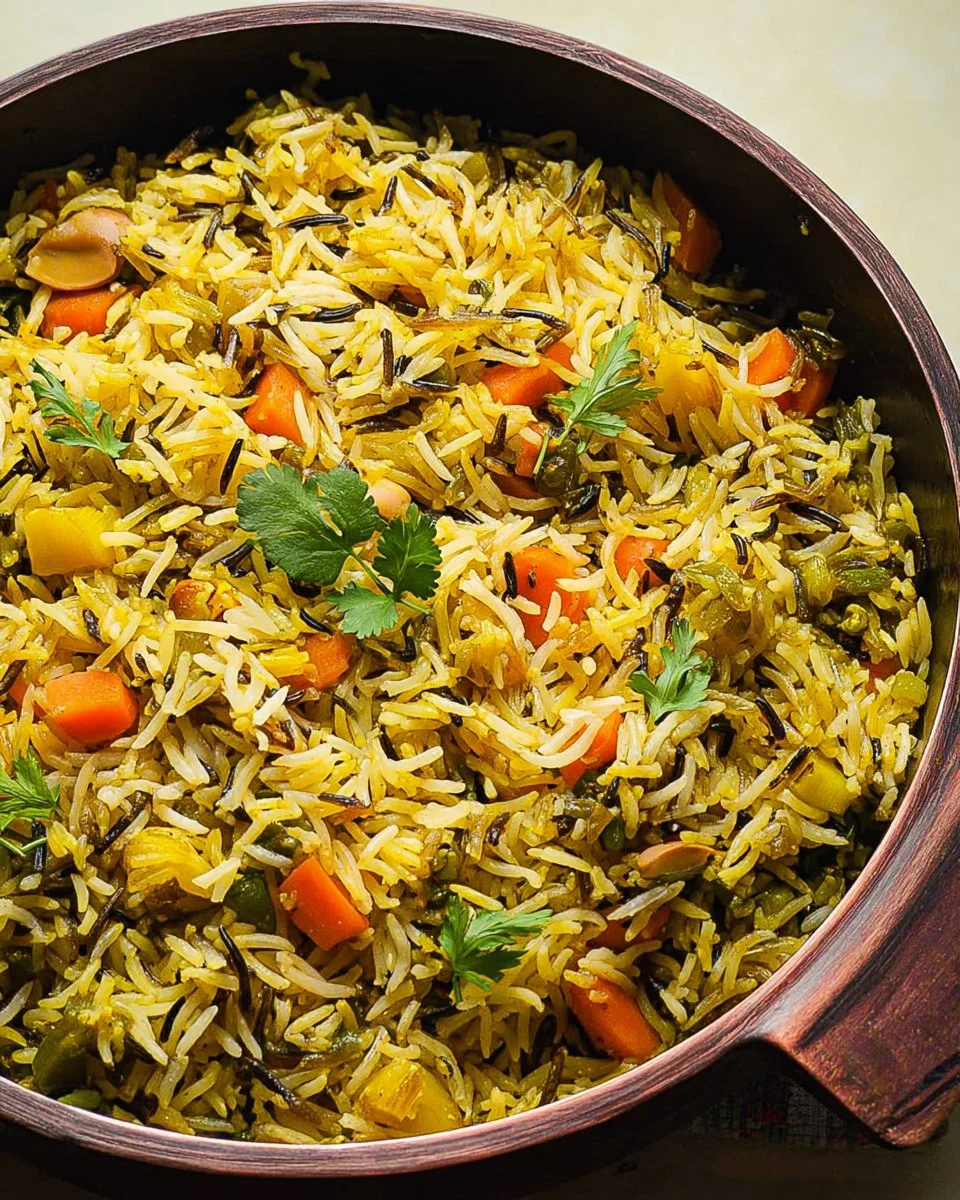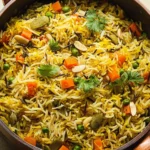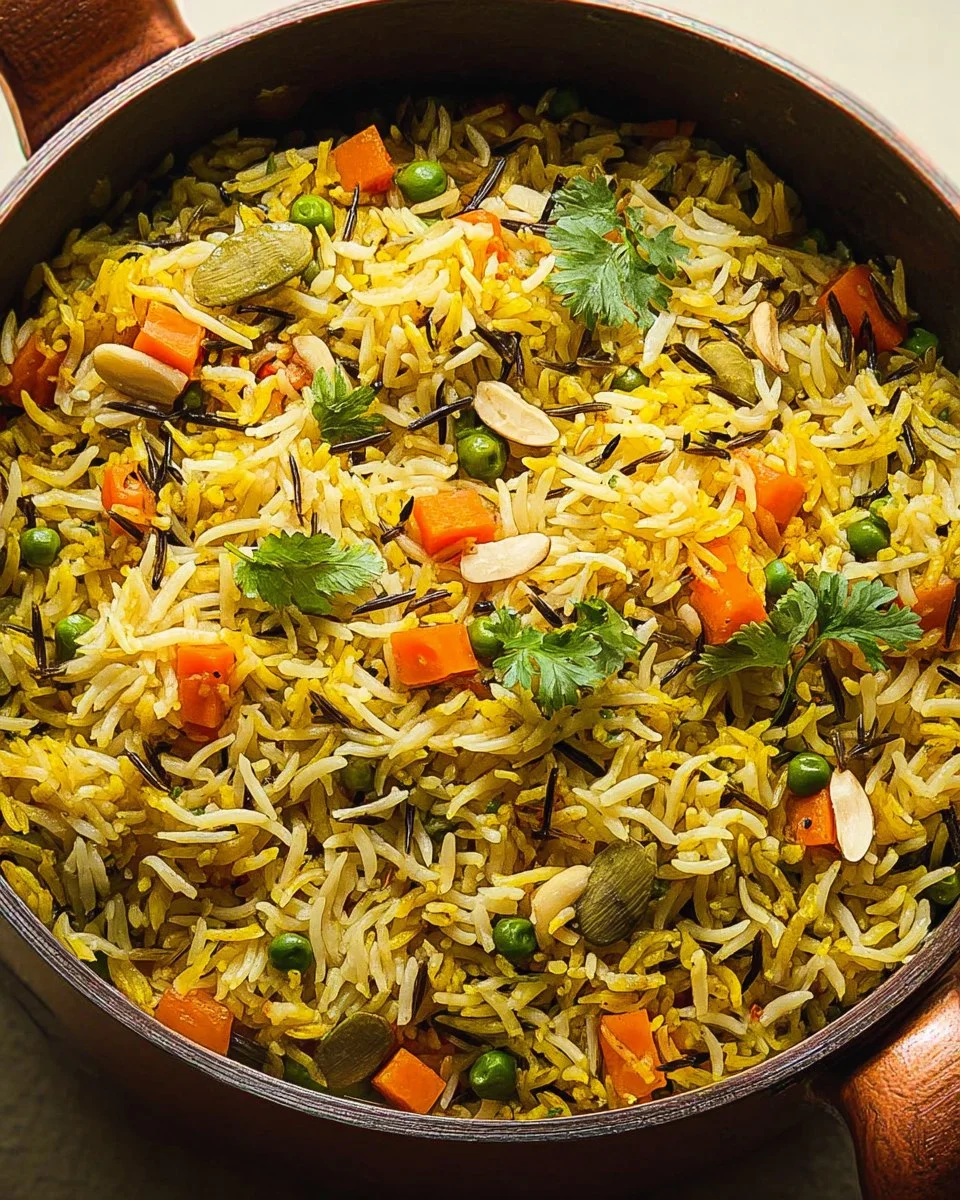Basmati and Wild Rice Pilaf with Vegetables is a delightful dish that tantalizes your senses with its aromatic spices, colorful veggies, and layered textures. The beautiful grains dance together in a medley that’s both comforting and vibrant, making it a perfect side for any curry or even a stand-alone meal. Picture the warm fragrance wafting through your kitchen as the rice cooks, merging the earthy tone of wild rice with the fluffy perfection of basmati. It’s the kind of dish that carries memories—perhaps of a family gathering where laughter mingled with the aroma of spices or a cozy weeknight dinner where each bite felt like a warm hug.
As the seasons shift, there’s something truly heartwarming about preparing a meal that brings comfort and nourishment. Whether you’re celebrating a special occasion or simply enjoying a quiet evening at home, cooking Basmati and Wild Rice Pilaf with Vegetables is sure to fill your heart and home with goodness. Let’s dive in and discover how this easy, visually appealing dish can become a staple in your kitchen.
Table of Contents
Why This Is The Best Basmati and Wild Rice Pilaf with Vegetables Recipe
This recipe for Basmati and Wild Rice Pilaf with Vegetables is not just about bringing flavors together; it’s about creating a memorable dining experience. With a simple prep time of just 10 minutes and a cooking time of 30 minutes, you’ll have an incredible dish ready in no time. The blend of spices brings an irresistible warmth, while the colorful veggies add a fresh crunch and visual appeal that makes your plate pop. Plus, it’s an incredibly flexible dish, perfect for accompanying anything from grilled meats to roasted vegetables. Whether for a casual weeknight dinner or a festive gathering, this pilaf fits any occasion and can easily be made vegan-friendly by using vegetable stock.

Ingredients You’ll Need
- Basmati and Wild Rice Mix: This beautiful blend offers the best of both worlds. Basmati provides aromatic fluffiness, while wild rice adds a chewy, nutty element. You can substitute with just basmati or brown rice if you prefer.
- Vegetable Oil (or Ghee): This is used for sautéing and adds a rich flavor. Ghee can enhance the taste further if you want that authentic Indian touch.
- Fresh Ginger: Adds a warm, fragrant note. Grated ginger is ideal for easy incorporation, but you can use ground ginger in a pinch.
- Garlic: Fresh crushed garlic contributes depth and aromatic goodness. Adjust according to your love for garlic!
- Salt: Essential for balancing flavors. Use sea salt for a hint of mineral taste or Himalayan pink salt for a pop of color and flavor.
- Turmeric: This golden spice adds not only color but also earthiness. It’s known for its health benefits, too.
- Cumin and Coriander: These spices create a warm flavor base. You can substitute them with curry powder if you want to change it up a bit.
- Cinnamon: Just a touch gives warmth and depth; don’t skip this!
- Cayenne Pepper: For those who enjoy a gentle heat, adjust based on your heat tolerance.
- Fresh Cilantro: This bright herb adds freshness to the dish, and it pairs beautifully with the spices. You can use parsley if you’re not a cilantro fan.
- Chicken or Vegetable Stock: Richness from the stock enhances the pilaf’s overall flavor. Use homemade stock for a fresher taste or go low-sodium if watching sodium intake.
- Frozen Vegetable Mix: A blend of peas, carrots, green beans, and corn is a go-to, but feel free to choose your favorite vegetables.
- Toasted Flaked Almonds (or Chopped Cashews): These add a delightful crunch and nutty flavor. Toast them in a dry pan for extra aroma.
How to Make Basmati and Wild Rice Pilaf with Vegetables

Wash and Soak
Start by washing the rice mix in cold water until the water runs clear. This crucial step removes excess starch, ensuring fluffier grains. After washing, soak the rice in water for about 30 minutes. Not only does this help achieve that fluffy texture, but it also reduces cooking time, making your pilaf lighter and more delightful.
Sauté Aromatics
In a large pan, heat the vegetable oil over medium heat. Once hot, add the grated ginger and crushed garlic, stirring gently for about 30 seconds until they become fragrant. Be careful not to let them brown too much—just enough to release their warmth without burning. This step forms the aromatic foundation of your pilaf, enhancing every layer of flavor that follows.
Combine Spices and Rice
Next, add the drained rice to the pan, stirring gently to combine with the ginger and garlic mixture. Allow the rice to sauté for about a minute till it’s lightly toasted. This brief frying stage intensifies the rice’s flavors and helps it absorb the spices. Then, sprinkle in the salt, turmeric, cumin, coriander, cinnamon, and cayenne pepper. Stir continuously until you can smell the aromatic spices permeating your kitchen, about 1-2 minutes.
Pour in the Stock
Now, it’s time to add your stock. Pour in the chicken or vegetable stock, and bring the mixture to a simmer. Once simmering, toss in the frozen vegetables along with the chopped fresh cilantro. Give everything a good stir to incorporate all those lovely flavors, then bring the pot to low heat, cover it with a lid, and let it cook undisturbed for about 15 minutes. This gentle cooking allows the rice to absorb moisture and the spices to infuse their warmth throughout, culminating in a wonderfully fragrant dish.
Fluff and Serve
After the 15 minutes, turn off the heat but keep the lid on for an additional 10 minutes. This resting time is just as important, as it allows for any remaining steam to finish cooking the rice. When ready, remove the lid and fluff the rice gently with a fork. Feel free to sprinkle additional cilantro and top with toasted flaked almonds or chopped cashews for an extra crunchy surprise that pairs wonderfully with the fluffy rice.
Tips for Success
- Rinse your rice well. This removes any excess starch, preventing clumping.
- Soak the rice for optimal fluffiness; it may also help cut down your cooking time.
- Sauté the spices until fragrant, but avoid burning for the best flavor.
- Let the pilaf rest post-cooking—it makes a world of difference in texture.
- Feel free to customize the vegetable mix based on your preference or seasonal availability.
- If you have leftover pilaf, toss in some additional fresh herbs or a squeeze of lemon juice before serving for a refreshing surprise.
Serve It With
To elevate your dining experience, consider serving this Basmati and Wild Rice Pilaf with Vegetables alongside your favorite curry dishes, grilled chicken, or even as part of a simple salad spread. It also pairs beautifully with yogurt-Based sauces, offering creaminess against the spices. For something different, consider adding a sprinkling of feta or goat cheese for a delightful counterbalance to the dish’s warmth, and don’t forget that crisp salad on the side to balance your meal.
How To Store & Reheat Leftovers
For leftovers, refrigerate the pilaf in an airtight container for up to 4 days; the flavors will actually develop further. For longer storage, you can freeze the pilaf for up to 3 months. Just ensure it’s well-wrapped in a freezer-safe container. When you’re ready to enjoy, reheat in the microwave for a couple of minutes or on the stovetop over medium heat, adding a splash of stock or water to rejuvenate the moisture. Just be mindful that freezing may slightly alter the texture, but a little extra fluffing while reheating can help!
Tips & Variations
Looking to switch things up? Here are some flavor variations to consider:
- Herb Variations: Try adding fresh parsley or mint for a fresh flavor twist.
- Spice Swaps: Experiment with different spices like garam masala or smoked paprika to change the dish’s profile completely.
- Vegetable Swaps: Use seasonal vegetables or what you have on hand—zucchini, bell peppers, or spinach can work beautifully.
- Vegan Twist: Use vegetable broth instead of chicken stock, and incorporate chickpeas for protein.
Recipe FAQs
Can I make this recipe vegan?
Absolutely! Simply replace the chicken stock with vegetable stock, and enjoy a hearty vegan side dish that’s packed with flavor and nutrients.
How can I customize the vegetable mix?
Feel free to use any frozen or fresh vegetables you enjoy—broccoli, bell peppers, or even roasted mushrooms can be wonderful additions based on your preference.
Can I prepare this pilaf ahead of time?
You can prepare this dish ahead of time and reheat it just before serving. This makes it not just practical for weeknight dinners but also great for potlucks or family gatherings.
Do I need to soak the rice?
Yes, soaking the rice for around 30 minutes helps ensure fluffy results by allowing the grains to swell before cooking, which aids even cooking.
In conclusion, Basmati and Wild Rice Pilaf with Vegetables stands as a simple yet versatile dish that offers comfort and nourishment. It’s filled with flavors and textures that please the senses, making it a perfect addition to any meal. Don’t hesitate to get creative with variations and explore different flavor combinations. We invite you to enjoy this delicious pairing, perfect for sharing around the table with family and friends!
PrintMore Dinner Recipes
- Spicy Tomato Gnocchi with Bacon
- Easy Slow Cooker Turkey Breast
- Roasted Pork and Apples
- 5 Minute Ravioli Sauce
- Vegetable Cabbage Soup with Potatoes and Carrots
Recipe Card

Basmati and Wild Rice Pilaf with Vegetables
- Prep Time: 10 minutes
- Cook Time: 30 minutes
- Total Time: 40 minutes
- Yield: 4 servings
- Category: Side Dish
- Method: Stovetop
- Cuisine: Indian
Description
This Basmati and Wild Rice Pilaf with Vegetables offers a comforting blend of flavors and textures, making it a perfect side dish or a hearty meal on its own.
Ingredients
- Basmati and Wild Rice Mix
- Vegetable Oil (or Ghee)
- Fresh Ginger
- Garlic
- Salt
- Turmeric
- Cumin
- Coriander
- Cinnamon
- Cayenne Pepper
- Fresh Cilantro
- Chicken or Vegetable Stock
- Frozen Vegetable Mix
- Toasted Flaked Almonds (or Chopped Cashews)
Instructions
- Wash and soak the rice mix in cold water for about 30 minutes to remove excess starch.
- Heat the vegetable oil in a large pan over medium heat. Add grated ginger and crushed garlic and sauté until fragrant.
- Add drained rice to the pan and sauté for about a minute, then stir in salt, turmeric, cumin, coriander, cinnamon, and cayenne pepper.
- Pour in the stock and bring to a simmer. Add frozen vegetables and fresh cilantro, stir to combine, cover, and cook for 15 minutes.
- Remove from heat, keep covered for 10 additional minutes, then fluff the rice with a fork before serving.
Notes
Rinse the rice well to ensure fluffiness; soaking helps reduce cooking time.
Customize the vegetable mix based on preference or seasonal availability.
Leftovers can be refrigerated for up to 4 days or frozen for up to 3 months.
Nutrition
- Serving Size: 1 cup
- Calories: 240
- Sugar: 2g
- Sodium: 300mg
- Fat: 7g
- Saturated Fat: 1g
- Unsaturated Fat: 6g
- Trans Fat: 0g
- Carbohydrates: 40g
- Fiber: 5g
- Protein: 6g
- Cholesterol: 0mg







